Cool Jobs: Bringing paleontology to the people
Meet three extraordinary paleontologists who inspire, motivate and even help entertain us
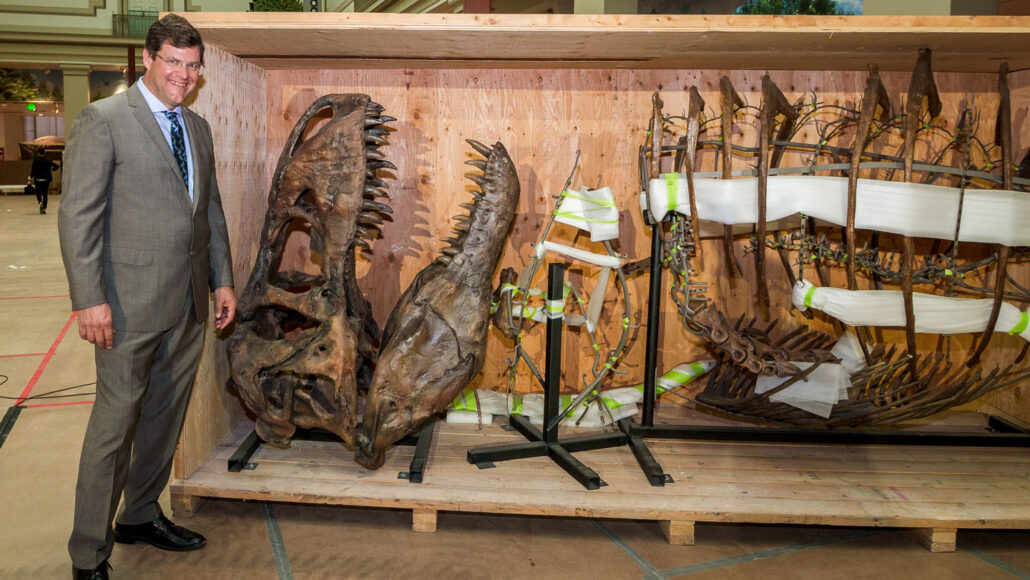
Museum Director Kirk Johnson poses with a Tyrannosaurus rex fossil that has just arrived for installation at the Smithsonian’s National Museum of Natural History, in Washington, D.C.
Jeremy Snyder, Smithsonian Institution
By Beth Geiger
It was just another day on the set of the movie studio in Burbank, Calif. Paleontologist Jack Horner took his seat next to director Steven Spielberg. But Horner wasn’t thinking about the famous director, his previous hits (Indiana Jones, Jaws and more) or the movie stars on the set. Instead, he was thinking about teeth. Specifically, dinosaur teeth.
Horner was the official dinosaur expert for this film — Jurassic Park. It was the first of six movies in the Jurassic Park and Jurassic World franchise. He knew that dinosaurs constantly grew new teeth, shedding old ones along the way. “I thought we should show teeth lying around,” he says.
But making such a change to a movie already filming would require more of the movie-planning diagrams called storyboards. It would mean more cameras and lighting. Sets would have to be moved. Shoot schedules would need to be altered.
This is why there are no piles of dinosaur teeth on screen when you watch Jurassic Park. As Horner was learning, real movies and real science don’t always quite match. But movies can still be great ways to get people interested in dino science.
Horner and other paleontologists, after all, know that fossils rock — including dinosaur teeth. Finding fossils is a thrill. Learning about them teaches us much about Earth’s past and even its future. But some paleontologists, such as Horner, have gone beyond digging and studying fossils. They now work to inspire, educate and entertain. They direct museums, bring students into the field and even connect with Hollywood to get the science picture perfect.

Educators and Parents, Sign Up for The Cheat Sheet
Weekly updates to help you use Science News Explores in the learning environment
Thank you for signing up!
There was a problem signing you up.
A movie dino-sty
In the Jurassic Park and Jurassic World movies, live dinosaurs enthrall human visitors. The animals graze in herds. Their relatives soar overhead. Naturally, some of the prehistoric reptiles escape, causing terror and destruction. The hero in the first Jurassic Park movie? A paleontologist, of course. Alan Grant, played by actor Sam Neill, was actually inspired in part by Horner.
Horner is an authority on dinosaurs, especially their behaviors and social patterns. His childhood teachers, however, are not likely to have ever suspected where a career would take the boy. Growing up in a small Montana town, Horner was fascinated by dinosaurs. Even as a child he knew a lot about paleontology. “Collecting fossils was something I was doing very well,” he says. He won science fairs with comparative studies of fossils from different regions.
But he also got Ds and Fs in school. He struggled with reading because he had dyslexia, a learning disorder. His teachers had assumed Horner was a poor, or even lazy, student. Even as a college student, Horner struggled. So he worked in museums, joined the military and continued searching for fossils.
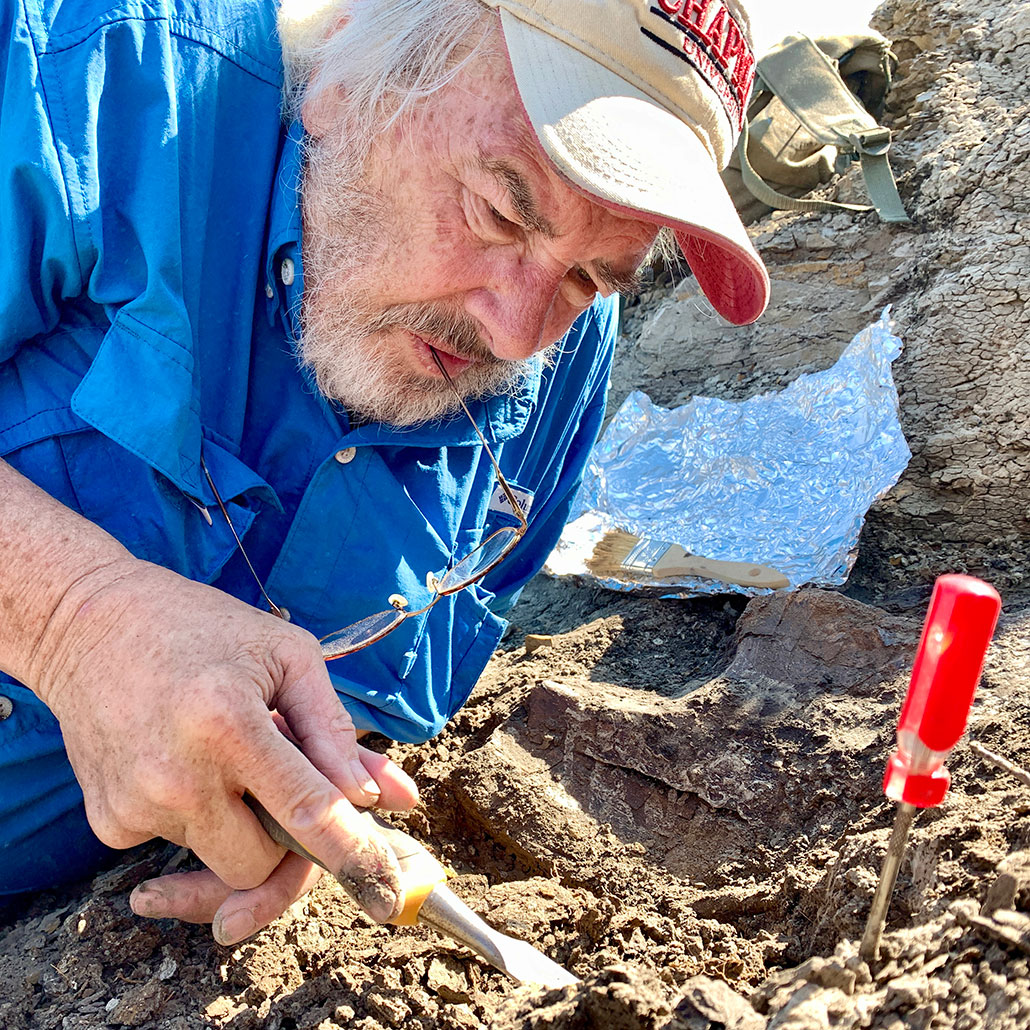
Then in 1978, Horner and his team discovered fossils of baby duckbilled Maiasaura dinosaurs. They had been digging on a Montana mountainside. Nearby, they found 14 nests of dinosaur eggs, along with fossils representing all stages of Maiasaura life. The discovery cracked open age-old mysteries about the social behaviors of dinosaurs. It showed that these animals had lived in groups and cared for their young. It also put Horner in the public eye.
He published a book in 1988, Digging Dinosaurs, about his search for baby dinosaurs. Not long after, Spielberg began working on a new movie about an attraction where visitors could see real dinosaurs created by scientists.
Of course, depicting dinosaurs and people together is pure fiction. After all, dinosaurs went extinct 65 million years before humans appeared. Still, Spielberg was determined to make the creatures as realistic as he could. Did real dinosaurs roar? Did they roam in herds? What did their skin look like?
He needed a technical advisor to help answer such questions. So Spielberg turned to Horner.
“My job was to make sure the dinosaurs looked as accurate as possible,” Horner explains. He also provided the Hollywood team with an example of a real working paleontologist. In the movie, Alan Grant dresses similar to the way Horner did for his fieldwork. The dinosaur dig shown in Jurassic Park was also based on the research site Horner was running in Montana. And in the movie, kids at the dig carry a red book that looks a lot like his Digging Dinosaurs.
“When we started shooting, I sat next to Steven,” Horner recalls. “He would ask me details.” Even so, the reality of making a movie sometimes conflicted with dinosaur reality. “We knew raptors should be feathered, but mechanically it wasn’t possible,” he says. Still, “I think they did very well,” says Horner of the films’ depiction of Jurassic life.
The incredible success of Jurassic Park helped bring visitors and funding to the Museum of the Rockies in Bozeman, Mont. This venue showcases dinosaurs found in Montana. Horner was curator of paleontology there until he retired in 2016. He played a big role in expanding the museum.
“As a dyslexic kid growing up in rural Montana, I never would have guessed my future,” he says. “I’ve had an extraordinary life.”
Days at the museum
Bringing dinosaurs onto the big screen is one way to get the attention of non-scientists. Leading a museum that attracts 5 million visitors every year is another. That’s paleontologist Kirk Johnson’s job. He is the director of the Smithsonian’s National Museum of Natural History, in Washington, D.C. The museum brings Earth’s past — and future — to a curious public. It holds a collection of 145 million specimens and artifacts. These include many, many dinosaur fossils.
Museums are basically giant treasure chests, says Johnson. And the treasure-filled museum he leads is among the world’s largest. It’s a job this paleontologist is thrilled to have: “I always say I’m like a big kid.”
Johnson has always loved museums. He was 14 when he started volunteering at the Burke Museum in Seattle, Wash. Later, he earned a PhD in paleontology, focusing on fossil plants. In 2014, after leading Denver’s Museum of Natural History for 22 years, Johnson got the call to head one of the biggest and best natural history museums in the world. “As director, I get to field the big ideas. I’m more like a coach than a player,” he explains.
The Smithsonian is a perfect match for Johnson’s big ideas about geology, fossils and natural history. “Fossils tell the amazing story of our planet,” he says. “I love the collection, and I love the displays.”
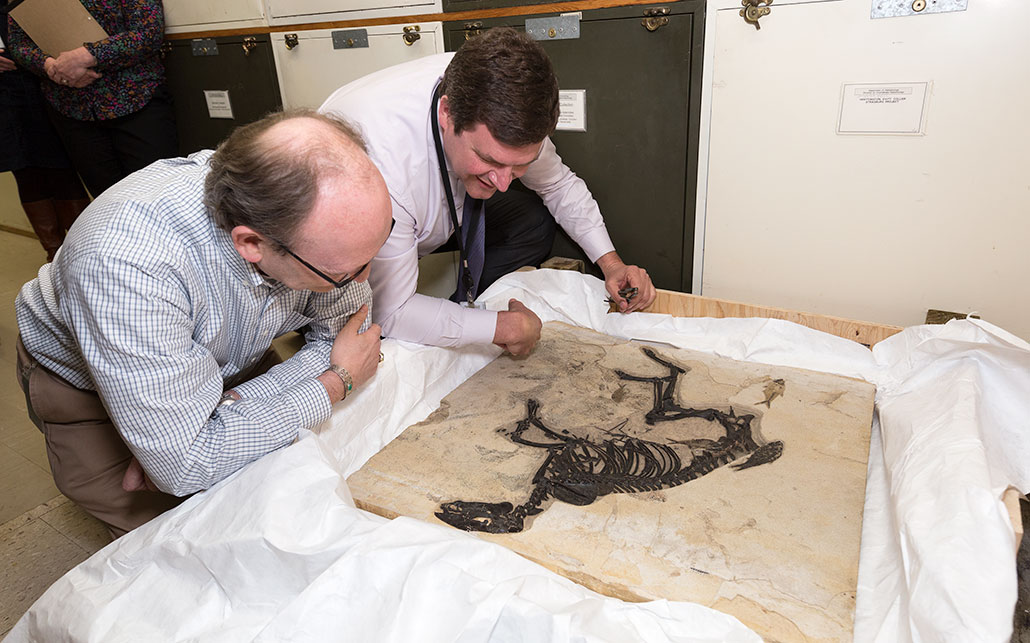
When Johnson arrived at the museum, curators were in the midst of a huge project —overhauling the old fossil exhibit. Johnson helped create the new one: Hall of Fossils — Deep Time, which finally opened in June 2019. The exhibit takes visitors on a trip through all 4.6 billion years of Earth’s history. People see fossils from the beginnings of life to the first fish, flowers and mammals. They follow evolution and extinctions. And of course, they see dinosaurs. The Tyrannosaurus rex skeleton, for instance, clamps its jaws around a Triceratops. Finally, visitors explore the future of Earth. They learn how impacts like shifting climates and landscapes are changing our world.
The fantastic exhibit is just one of many at this museum. Yet, Johnson points out, exhibits are just the tip of the iceberg. Some 99.99 percent of the museum’s objects are not on display. Behind the scenes, they fill cabinets, drawers, shelves and entire storage facilities. Researchers continually study this vast collection to learn more about our world. “The memory of our planet is here,” Johnson explains.
He shared his knowledge and zeal for geology on the popular PBS television series NOVA. In “Making North America,” he took viewers across the continent to explore the science behind the scenery.
He’s also piled into a dusty pickup truck with artist Ray Troll for several epic road trips. Together, they visited dozens of fossil museums and locations, big and small. Artist and scientist working together, they’ve created several fun books about these trips, such as Cruisin’ the Fossil Freeway.
“After driving a few thousand miles with him and going to a jillion fossil sites and countless museums, I’ve come to appreciate that Kirk’s one of the most knowledgeable, down to Earth, affable and totally approachable guys you could ever hope to meet,” says Troll. Those are some of the reasons, he says, why Johnson is the perfect person to head the National Museum of Natural History.
Back at the Smithsonian, every day brings a new addition to the collection, or another opportunity to make the museum even better or more exciting. “I never have two days the same,” says Johnson.
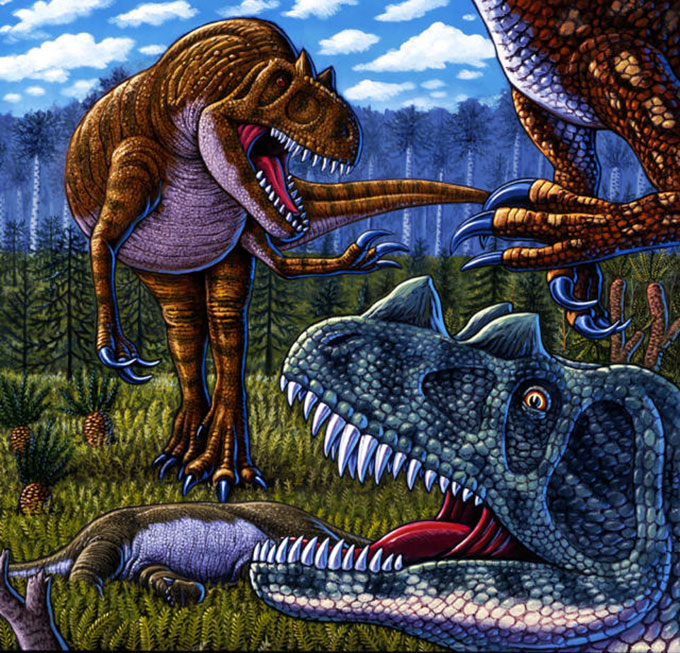
Digging for diversity
Museums bring science to the public. But to really inspire people with the thrill of science in action, some paleontologists like to bring people to the science. Lisa White is one of them.
On a hot summer day under a blue Montana sky, a group of high school and college students dig into a dusty mountainside. They don’t mind wiping a little sweat and dirt from their faces for the chance to uncover dinosaurs. In fact, they are stoked to be doing real fieldwork. Led by White, these students have traveled thousands of kilometers (miles) for the experience.
White directs educational programs at the University of California Museum of Paleontology in Berkeley. She has a mission: encourage students from all backgrounds to appreciate geoscience. Some may one day even become Earth scientists themselves.
White loved visiting museums when she was young, but she wasn’t really thinking about Earth science back then. Instead, she favored seeing the world through photography. Her focus changed when she took a geology course in college. She went on to study tiny fossils, called microfossils. Then she began teaching at San Francisco State University.
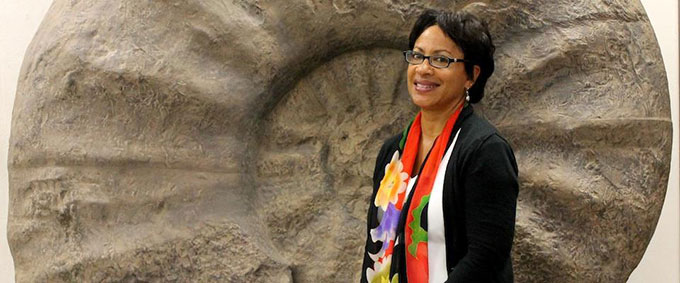
With a passion to inspire learning, White created a geology program for high schoolers in the San Francisco area called SF-ROCKS. After that program ended, White started another: METALS. That’s short for Minority Education through Traveling and Learning in the Sciences. These programs connected diverse students from urban backgrounds with Earth science. Some kids learned about fossils that lay buried underfoot. Others were taught how a changing climate might impact their drinking water. White arranged trips to national parks, a nearby shoreline and a dinosaur dig in Montana. She was even featured with Johnson on an episode of “Making North America.”
As a student, White was especially inspired by field trips. She used these programs to give the same opportunities to students from the San Francisco area. Jim Neiss-Cortez is an educator who directed the SF-ROCKS program. “For years, Lisa filled a van with high schoolers she didn’t know and toured with them for two weeks across the west and central plains,” recalls Neiss-Cortez. “Now if that isn’t dedication to youth, I don’t know what is!”
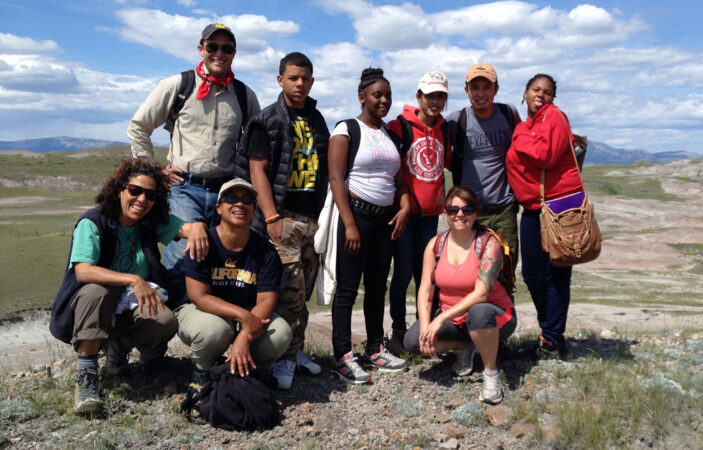
Now at the paleontology museum in Berkeley, White works mainly with college students. She organizes geology field programs with other colleges. She also arranges for students to join weeklong trips on sea-going research ships.
White knows that for students living in cities or suburban places, it’s not always obvious why geology matters. So she looks for ways to make the connection clear. Fossils are a good start. “Paleontology helps us understand the diversity of life today,” she says.
Beyond fossils, Earth science includes plenty of other things that matter every day, from earthquakes to water quality and climate change. It’s key to environmental justice, where communities of color can be disproportionately affected by pollution. “That boils down to people’s health,” White says. These issues hit home no matter where someone lives.
The field of Earth science is not yet known for much diversity. Through her leadership, White hopes to change that. “We need to make Earth science more relevant to more people,” she says. In fact, she adds, “If any time is important for that, it’s now.”







